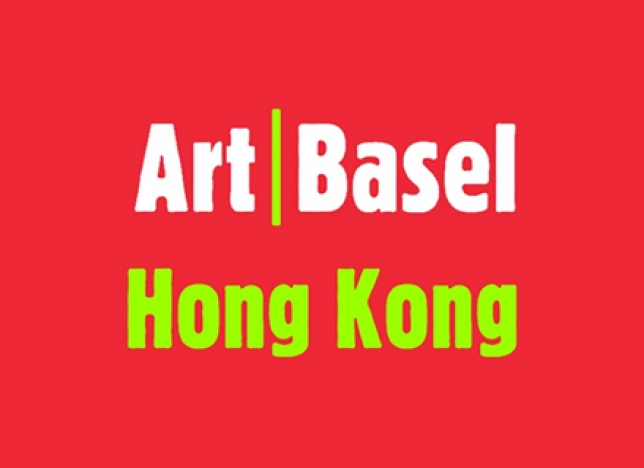Jiechang Yang
Born 1956 Foshan, Guangdong Province, China
Lives and works in Paris, France and Heidelberg, Germany
Taoism provided Yang Jiechang a mental and spiritual language in which to construct his work. He chose to renounce all colour, all representation, all allusion and all symbolism. Painting only in Chinese ink, and layered with collaged rice paper, the pictures themselves appear black across the entire surface. However, they are not uniform - the collaged, textured sections pick up and reflect light, while the flat, dark edges absorb it. The simplicity of the forms are rich, allowing both darkness and light to come together on a single surface.
For a decade between 1989 and 1999, Yang worked on the series "100 Layers of Ink" – the result of focused repetition. For this series Yang applied ink to the same pieces of paper, day after day, until the paper was completely saturated. As the paper reached saturation, the ink took on a shimmery, luminescent quality, and the paper itself shifted from a two-dimensional surface to a three-dimensional object. Merging figure and ground, the works moved into the realm of sculpture. Yang reinvented these materials, customarily employed by literati to produce traditional paintings, imbuing his own meditative process and exploration of materiality.
Yang Jiechang studied at the Institute of Popular Art in Foshan, and later in Peking. In 1982 he was appointed teacher at the Academy of Arts, Canton. His training was principally in traditional Chinese painting, and the ancient technique of collage on paper. One of the most important aspects of his work, comments Yang Jiechang, is that "the process of the work and its results are a kind of meditation. What they reflect and express for the recipient also belongs to the realm of meditation". In 2013 Yang Jiechang’s work was featured in the first group show devoted solely to the contemporary art of China "Ink Art, Past as Present in Contemporary China" at the Metropolitan Museum of Art in New York. In 2015 the Deichtorhallen – museum of contemporary art in Hamburg, Germany – will stage a solo show with Yang Jiechang.
CV
Selected solo exhibitions include: "Yang Jiechang–I often do bad things", Deichtorhallen/Phoenixhalle, Hamburg, Germany (2014), "Stranger than Paradise" at the La Criée, Centre d’art Contemporain, Rennes, France (2011), "Underground Flowers" at the Muséum d’Histoire Naturelle de Rouen, Festival Automne en Normandie, France (2010), "No/Shadow Kick" at the Duolum Museum of Modern Art, Shanghai, China (2008), "In God We Trust" at the Stanford University Medical School, Stanford, California, USA (2008), "Hei Ji Sheng Xiang" at the Shenzhen Painting Institute, China (2005), "Lookchat" at Centre A, Vancouver International Centre for Contemporary Asian Art, Vancouver, Canada (2003) and "Der längste Tag" at the Kunstverein Nürtingen, Nürtingen, Germany (2002).
Yang Jiechang also staged in numerous group exhibitions that include: "Advance through Retreat" at the Rockbund Art Museum, Shanghai, China (2014), "China's Changing Landscape" at the Nordic Watercolor Museum, Sweden (2014), "Zizhiqu/Autonomous Regions" at the Times Museum Guangzhou, China (2013), "From Gesture to Language" at the Rockbund Art Museum, Shanghai, China (2013), "Yuandao" at the Hong Kong Museum of Art, Hong Kong (2013), "Ink Art, Past as Present in Contemporary China" at the Metropolitan Museum, New York, US (2013), "The World Belongs to You" at the Palazzo Grassi, Fondation F. Pinault, Venice, Italy (2011), "Death Matters" at the Tropenmuseum, Amsterdam, The Netherlands (2011), "Hareng Saur: Ensor et l’art contemporain" at the MSK and S.M.A.K., Ghent, Belgium (2010) and "Thirty years of Contemporary Chinese Art" at the Minsheng Museum, Shanghai, China (2010).
Yang Jiechang has participated in various international art fairs that include: Art Basel Hong Kong, Hong Kong (2015), Shanghai Biennale, Shanghai, China (2012), Lyon Biennial, Lyon, France (2009), Venice Biennale, Tibetan Pavilion, Edicola Notte, Venice, Italy (2008), 3rd Guangzhou Triennial, Guangdong Museum of Art, Guangzhou, China (2008), Istanbul Biennial, Istanbul, Turkey (2007), Liverpool Biennial, Liverpool, UK (2006) and in the 5th Shenzheng International Ink Painting Biennial, Shenzheng, China (2006).
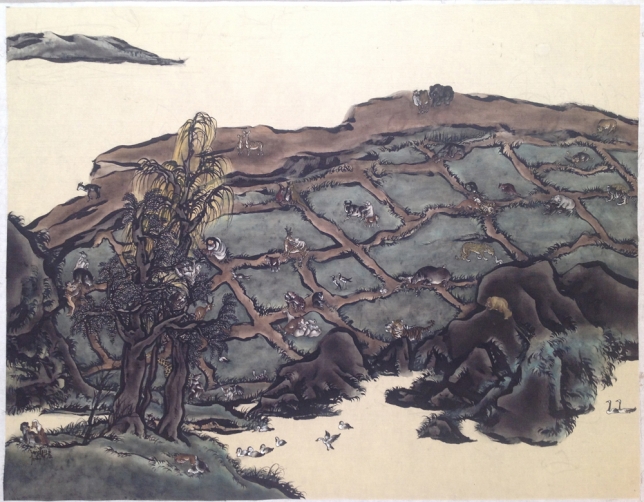 Jiechang Yang, Green Field, 2009, ink and mineral colors on silk, mounted on canvas, 95,5 × 121,5 cm, YANG0031
Jiechang Yang, Green Field, 2009, ink and mineral colors on silk, mounted on canvas, 95,5 × 121,5 cm, YANG0031
Apr 28, 2014
CURRENT SOLO EXHIBITION WITH YANG JIECHANG AT ARNDT BERLIN - On the occasion of the Gallery Weekend
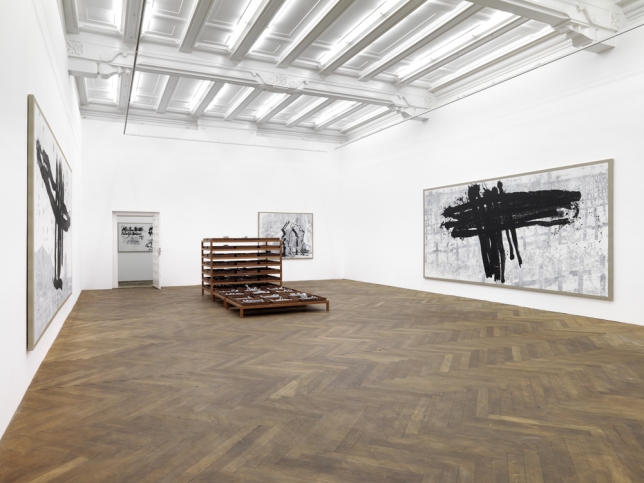 Jiechang Yang, Die Rechnung bitte, Installation view, ARNDT Berlin, 2014
Jiechang Yang, Die Rechnung bitte, Installation view, ARNDT Berlin, 2014
 Jiechang Yang, Die Rechnung bitte, Installation view, ARNDT Berlin, 2014
Jiechang Yang, Die Rechnung bitte, Installation view, ARNDT Berlin, 2014
 Yang Jiechang, Je ne veux pas travailler (Tale of the 11th Day Series), 2012, Ink and mineral colors on silk, mounted on canvas, 140 x 388 cm | 55.12 x 152.76 in, # YANG0011
Yang Jiechang, Je ne veux pas travailler (Tale of the 11th Day Series), 2012, Ink and mineral colors on silk, mounted on canvas, 140 x 388 cm | 55.12 x 152.76 in, # YANG0011
 Yang Jiechang, Underground Flowers, 1989- 2009, 2009, Human bones made from porcelain 54 wooden boxes with silkprints (each 50 x 50 x 6 cm) wooden shelve with 9 layers, each shelf, 170 x 115 x 168 cm, # YANG0001
Yang Jiechang, Underground Flowers, 1989- 2009, 2009, Human bones made from porcelain 54 wooden boxes with silkprints (each 50 x 50 x 6 cm) wooden shelve with 9 layers, each shelf, 170 x 115 x 168 cm, # YANG0001
 Yang Jiechang, Wie im Himmel so auf Erden (Himmel), 2014, Ink and acrylic on paper, mounted on canvas, 227 x 488 cm | 89.37 x 192.13 in, # YANG0012
Yang Jiechang, Wie im Himmel so auf Erden (Himmel), 2014, Ink and acrylic on paper, mounted on canvas, 227 x 488 cm | 89.37 x 192.13 in, # YANG0012
 Yang Jiechang, Wie im Himmel so auf Erden (Erde), 2014, Ink and acrylic on paper, mounted on canvas, 227 x 488 cm | 89.37 x 192.13 in, # YANG0013
Yang Jiechang, Wie im Himmel so auf Erden (Erde), 2014, Ink and acrylic on paper, mounted on canvas, 227 x 488 cm | 89.37 x 192.13 in, # YANG0013
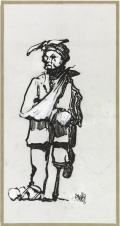 Yang Jiechang, Die Rechnung bitte,1924-2014, 2014, Ink and acrylic on paper, mounted on canvas, 240 x 126 cm | 94.49 x 49.61 in, # YANG0014
Yang Jiechang, Die Rechnung bitte,1924-2014, 2014, Ink and acrylic on paper, mounted on canvas, 240 x 126 cm | 94.49 x 49.61 in, # YANG0014
 Yang Jiechang, After the Battle, 1915-2015, 2014, Ink and acrylic on paper, mounted on canvas, 102 x 186 cm | 40.16 x 73.23 in, # YANG0015
Yang Jiechang, After the Battle, 1915-2015, 2014, Ink and acrylic on paper, mounted on canvas, 102 x 186 cm | 40.16 x 73.23 in, # YANG0015
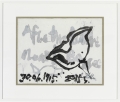 Yang Jiechang, After the Batlle 2, 1915-2015, 2014, Ink and acrylic on paper, mounted on canvas, 40,5 x 52 cm | 15.94 x 20.47 in, # YANG0016
Yang Jiechang, After the Batlle 2, 1915-2015, 2014, Ink and acrylic on paper, mounted on canvas, 40,5 x 52 cm | 15.94 x 20.47 in, # YANG0016
 Yang Jiechang, Oh,My God, 2002, Diptych, Ink and acrylic on on canvas; with 2 videos: "Oh, My God" and "Oh, Diu" each, 103,5 x 73,5 cm | 40.75 x 28.94 in, # YANG0017
Yang Jiechang, Oh,My God, 2002, Diptych, Ink and acrylic on on canvas; with 2 videos: "Oh, My God" and "Oh, Diu" each, 103,5 x 73,5 cm | 40.75 x 28.94 in, # YANG0017
 Yang Jiechang, Oh, My God / Oh Diu, 2002, 2 Videos as a Diptych Oh my God, 2,9 min Oh Diu: 4,08 min, Number 2 from an edition of 5, # YANG0023
Yang Jiechang, Oh, My God / Oh Diu, 2002, 2 Videos as a Diptych Oh my God, 2,9 min Oh Diu: 4,08 min, Number 2 from an edition of 5, # YANG0023
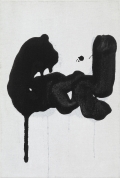 Yang Jiechang, God, 2014, Ink and acrylic on canvas, 43 x 29 cm | 16.93 x 11.42 in, # YANG0018
Yang Jiechang, God, 2014, Ink and acrylic on canvas, 43 x 29 cm | 16.93 x 11.42 in, # YANG0018
 Yang Jiechang, Important, 2014, Ink and acrylic on canvas, 48 x 68 cm | 18.9 x 26.77 in, # YANG0019
Yang Jiechang, Important, 2014, Ink and acrylic on canvas, 48 x 68 cm | 18.9 x 26.77 in, # YANG0019
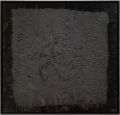 Yang Jiechang, 100 Layers of Ink/ 1, 1993, Ink on Xuan paper and gauze, framed: 108 x 110 cm | 42.52 x 43.31 in, # YANG0020
Yang Jiechang, 100 Layers of Ink/ 1, 1993, Ink on Xuan paper and gauze, framed: 108 x 110 cm | 42.52 x 43.31 in, # YANG0020
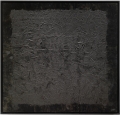 Yang Jiechang, 100 Layers of Ink/ 2, 1993, Ink on Xuan paper and gauze, framed: 108 x 110 cm | 42.52 x 43.31 in, # YANG0021
Yang Jiechang, 100 Layers of Ink/ 2, 1993, Ink on Xuan paper and gauze, framed: 108 x 110 cm | 42.52 x 43.31 in, # YANG0021
 Yang Jiechang, Arc de Triomphe (weiss), 1914-2014, 2014, Ink and acrylic on on canvas, mounted on canvas, 152 x 191 cm | 59.84 x 75.2 in, # YANG0022
Yang Jiechang, Arc de Triomphe (weiss), 1914-2014, 2014, Ink and acrylic on on canvas, mounted on canvas, 152 x 191 cm | 59.84 x 75.2 in, # YANG0022
 Jiechang Yang, Die Rechnung bitte, Installation view, ARNDT Berlin, 2014
Jiechang Yang, Die Rechnung bitte, Installation view, ARNDT Berlin, 2014
YANG JIECHANG
DIE RECHNUNG BITTE
Solo exhibition at ARNDT Berlin
May 3 - June 28, 2014
Yang Jiechang and Matthias Arndt on 'Die Rechnung bitte' show at ARNDT Berlin
PRESS: Please find the ARTBERLIN.DE article and video here
Press release
ARNDT Berlin is pleased to present the solo exhibition ‘Die Rechnung bitte’ of the internationally recognized Chinese artist Yang Jiechang in Berlin.
His works are an expression and a result of a sustained questioning and redefining of the own identity refering to diverse cultures, which he encounters with a great directness. Incidental circumstances of diverse places turn to basic elements as the recurrence, overlapping and intersection of disparate images. He chooses major issues as his main theme, but his inspiration and imagination arise from the banal and common objects. His works cover a large span of media and languages (as ink-wash painting, Chinese calligraphy, drawing, photography, installation, performance, sound, music and multimedia).
The title of the exhibition ‘Die Rechnung bitte’ descends from a work of Yang Jiechang, showing a crippled soldier, standing on a peg leg, with his head and right arm bandaged. This work is part of a series in which Yang Jiechang retraces and edits artworks by Adolf Hitler by trying to put himself into Hitler’s position. Hitler’s choice of subject was limited to images of the death, the suffering of his comrades and destruction of villages and monuments. According to Yang Jiechang we see no glorification of war, but just the opposite: For example, the triumphal arc – actually a symbol of victory and heroism – is represented as a destroyed ruin. The artist concludes an “image against the war”. By reciting some of Hitler’s works Yang Jiechang does not attempt to show the dictator but the artist himself: the reversal of something negative to something positive. There is an interplay, but anything than “the trivialization of the bloody madness”.
Yang Jiechangs works represents an interjection to maintain the critical distance to “search the enemy in oneself”. (Martina Köppel-Yang)
In another aspect of his approach he follows the mainstream propaganda, be it in the media context on topics like 9/11, the communist regime or everyday discourses of terror and war. He is using traditional techniques of Chinese painting in a contemporary frame and context.
In his calligraphy-diptych ‘Oh My God’, accompanied by two video installations, the attack of the World Trade Center in New York at September 11, 2001 form the initial point. At this juncture Yang isn’t interested in the aspects of the terror and horror, but rather in backgrounds and verbal expressions of the people, as the exclamation of a New York City citizen at the sight of the destroyed towers ‘Oh My God’. For Yang Jiechang it’s an expression of truth, which is why he picked out this sentence as an initial point for his calligraphy. The Cantonese equivalent ‘Oh Diu’, translated with ‘Fuck’, forms a convenient anti-pole. With his calligraphies he resists the Chinese tradition, to show only positive and beautiful, he rather shows the everyday occurrences, like banes and invectives: for Yang Jiechang words that apply to the whole last century. The language is a basic element in his works, an expression of cultural affiliation.
The installation ‘Underground Flowers’, produced for the twenty-year-old commemoration of the Tian’anmen massacre, where the military stopped protests of students pro-democracy movement in 1989, is a statement of Yang to the occurrence. The world isn’t getting better for him, even if flowers grow from the bones of the killed. The work was first shown at the 10th Biennale of Lyon, France, as in 2010 at S.M.A.K. in Gent, Belgium.
Yang Jiechang (1956 Guangdong, China) studied from 1974-78 at the Foshan Folk-Art Institute in Guangdong, China. In 1982 he graduated from the Chinese Painting department of the Guangzhou Fine Arts Academy, China. He has participated in several solo and group exhibitions in Asia, Europe, USA and Australia since 1988. He lives and works in Paris and Heidelberg.
Please click here to view the List of Artworks
Exhibitions
YANG JIECHANG
DIE RECHNUNG BITTE
Solo exhibition at ARNDT Berlin
May 3 - June 28, 2014
Yang Jiechang and Matthias Arndt on 'Die Rechnung bitte' show at ARNDT Berlin
PRESS: Please find the ARTBERLIN.DE article and video here
Press release
ARNDT Berlin is pleased to present the solo exhibition ‘Die Rechnung bitte’ of the internationally recognized Chinese artist Yang Jiechang in Berlin.
His works are an expression and a result of a sustained questioning and redefining of the own identity refering to diverse cultures, which he encounters with a great directness. Incidental circumstances of diverse places turn to basic elements as the recurrence, overlapping and intersection of disparate images. He chooses major issues as his main theme, but his inspiration and imagination arise from the banal and common objects. His works cover a large span of media and languages (as ink-wash painting, Chinese calligraphy, drawing, photography, installation, performance, sound, music and multimedia).
The title of the exhibition ‘Die Rechnung bitte’ descends from a work of Yang Jiechang, showing a crippled soldier, standing on a peg leg, with his head and right arm bandaged. This work is part of a series in which Yang Jiechang retraces and edits artworks by Adolf Hitler by trying to put himself into Hitler’s position. Hitler’s choice of subject was limited to images of the death, the suffering of his comrades and destruction of villages and monuments. According to Yang Jiechang we see no glorification of war, but just the opposite: For example, the triumphal arc – actually a symbol of victory and heroism – is represented as a destroyed ruin. The artist concludes an “image against the war”. By reciting some of Hitler’s works Yang Jiechang does not attempt to show the dictator but the artist himself: the reversal of something negative to something positive. There is an interplay, but anything than “the trivialization of the bloody madness”.
Yang Jiechangs works represents an interjection to maintain the critical distance to “search the enemy in oneself”. (Martina Köppel-Yang)
In another aspect of his approach he follows the mainstream propaganda, be it in the media context on topics like 9/11, the communist regime or everyday discourses of terror and war. He is using traditional techniques of Chinese painting in a contemporary frame and context.
In his calligraphy-diptych ‘Oh My God’, accompanied by two video installations, the attack of the World Trade Center in New York at September 11, 2001 form the initial point. At this juncture Yang isn’t interested in the aspects of the terror and horror, but rather in backgrounds and verbal expressions of the people, as the exclamation of a New York City citizen at the sight of the destroyed towers ‘Oh My God’. For Yang Jiechang it’s an expression of truth, which is why he picked out this sentence as an initial point for his calligraphy. The Cantonese equivalent ‘Oh Diu’, translated with ‘Fuck’, forms a convenient anti-pole. With his calligraphies he resists the Chinese tradition, to show only positive and beautiful, he rather shows the everyday occurrences, like banes and invectives: for Yang Jiechang words that apply to the whole last century. The language is a basic element in his works, an expression of cultural affiliation.
The installation ‘Underground Flowers’, produced for the twenty-year-old commemoration of the Tian’anmen massacre, where the military stopped protests of students pro-democracy movement in 1989, is a statement of Yang to the occurrence. The world isn’t getting better for him, even if flowers grow from the bones of the killed. The work was first shown at the 10th Biennale of Lyon, France, as in 2010 at S.M.A.K. in Gent, Belgium.
Yang Jiechang (1956 Guangdong, China) studied from 1974-78 at the Foshan Folk-Art Institute in Guangdong, China. In 1982 he graduated from the Chinese Painting department of the Guangzhou Fine Arts Academy, China. He has participated in several solo and group exhibitions in Asia, Europe, USA and Australia since 1988. He lives and works in Paris and Heidelberg.
Please click here to view the List of Artworks
ART BASEL HONG KONG 2015 - March 15 - 17, 2015
ARNDT is pleased to announce its participation at Art Basel Hong Kong 2015, taking place from March 15 - 17. We are looking forward to welcoming you at our BOOTH Hall 3 C30.
Participating Artists: Jumaldi Alfi, Stephan Balkenhol, Jigger Cruz, Wim Delvoye, Gilbert & George, Yang Jiechang, Heinz Mack, Rudi Mantofani, Vik Muniz, Eko Nugroho, Norberto Roldan, Arin Dwihartanto Sunaryo, Rodel Tapaya and Qiu Zhijie.
Please click here to see a preliminary list of the exhibited artworks
Venue:
Hong Kong Convention & Exhibition Centre
1 Harbour Road
Wan Chai, Hong Kong
ARNDT Berlin
Potsdamer Strasse 96
10785 Berlin
info@arndtberlin.com
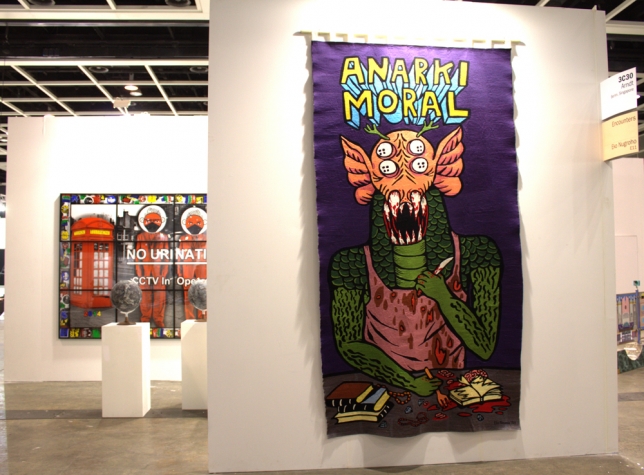 Installation View | Art Basel Hong Kong | March 15 - 17, 2015
Installation View | Art Basel Hong Kong | March 15 - 17, 2015
 Installation View | Art Basel Hong Kong | March 15 - 17, 2015
Installation View | Art Basel Hong Kong | March 15 - 17, 2015
 Installation View | Art Basel Hong Kong | March 15 - 17, 2015
Installation View | Art Basel Hong Kong | March 15 - 17, 2015
 Installation View | Art Basel Hong Kong | March 15 - 17, 2015
Installation View | Art Basel Hong Kong | March 15 - 17, 2015
YANG JIECHANG
Chinese Ink Drawings: 100 Layers of Ink
Solo exhibition at ARNDT Singapore
6 May - 23 June 2016
Opening | Friday | May 6, 2016, from 6 - 9 pm | at ARNDT Singapore
ARNDT and A3 are pleased to invite you to a party to celebrate the launch of our new space and offices at Gillman Barracks, Block 47.
ARNDT will present works by leading Chinese artist Yang Jiechang. Entitled 100 Layers of Ink, the pieces dating back to the late eighties and are the result of focused repetition and process.
Since his emigration to Europe in 1988 Yang Jiechang has worked on a series entitled 100 Layers of Ink. The first and most outstanding works of this series, a set of four large-scale ink paintings, were exhibited in the seminal show Les magiciens de la terre at the Centre Georges Pompidou, Paris in 1989. In these large monochrome black paintings, which are a continuation of his early abstract works, the dualistic principle of Taoism is evoked by the black and shiny surface of the ink shapes.
This series is the result of the artist applying ink to the same piece of paper, day after day, until the paper is completely saturated. Despite the materials employed sharing association to those used by literati to make traditional paintings, Yang reinvents them by entirely removing the artist’s gesture as an index of meaning. By obsessively building layers on layers of ink, thus creating a black object that does not display skill, imagery, or personality, Yang subverts the traditional technique and aesthetic appearance of traditional Chinese ink and wash painting. This position can be considered as a deconstruction of Chinese painting and its tradition into its basic elements: paper, water, and ink.
Taking on a shimmery, luminescent quality, the paper itself shifts from a two-dimensional surface to a three-dimensional object, merging figure and ground. The simple abstract forms seem to stretch beyond their margins and beyond the painting, recalling the process of sublimation of the self in meditation. The multiple layers of ink the artist applies to the paper connote time and enliven a black space. A major concept one can perceive throughout Yang's artistic oeuvre is that of the ambivalence of perception and experience. The artist looks for experiences that stimulate an insecurity in the viewer. Yang aims to push the perception of his work to extremes, to a point where mind and body, where the individual life and the life as natura naturans meet. This understanding of life again is related to Chan-Buddhism and to Taoist thought. Here individual life and life as a creative force of nature are regarded as an entity, as are its material and its spiritual aspects. Similarly, Yang Jiechang’s shiny black abstract works seem to dissolve into or emerge from an amorphous, yet spirited cosmos.
ARNDT Singapore
Gillman Barracks
Block 47
47 Malan Road
#01-25, Singapore 109444
info@arndtfineart.com
PRESS
High Snobiety | 10 Must-See Exhibitions Worldwide This Month | June, 2016
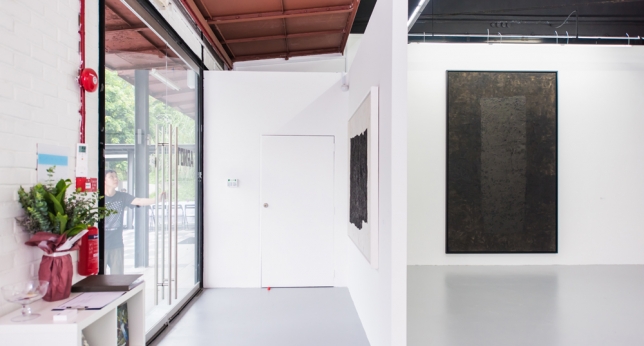 Installation view | Yang Jiechang | Arndt Singapore | 6 May - 31 July 2016
Installation view | Yang Jiechang | Arndt Singapore | 6 May - 31 July 2016
 Installation view | Yang Jiechang | Arndt Singapore | 6 May - 31 July 2016
Installation view | Yang Jiechang | Arndt Singapore | 6 May - 31 July 2016
 Installation view | Yang Jiechang | Arndt Singapore | 6 May - 31 July 2016
Installation view | Yang Jiechang | Arndt Singapore | 6 May - 31 July 2016
 Installation view | Yang Jiechang | Arndt Singapore | 6 May - 31 July 2016
Installation view | Yang Jiechang | Arndt Singapore | 6 May - 31 July 2016


















